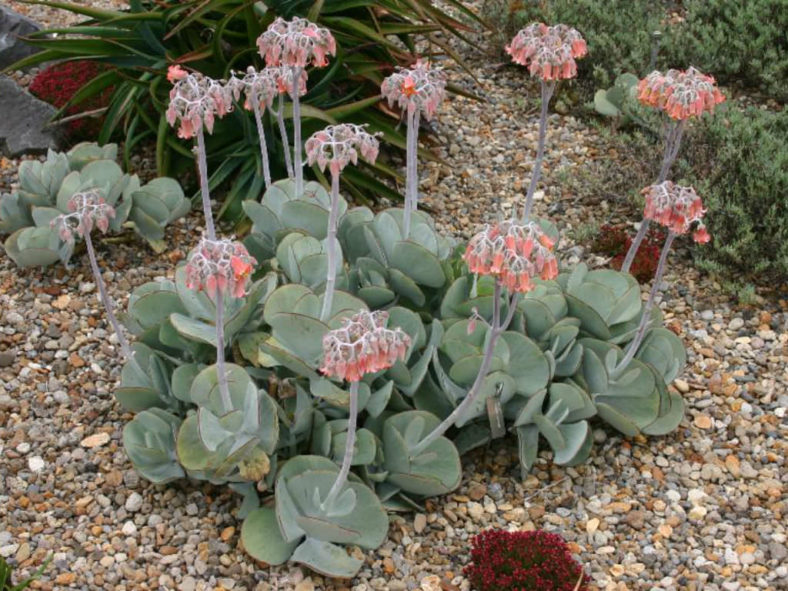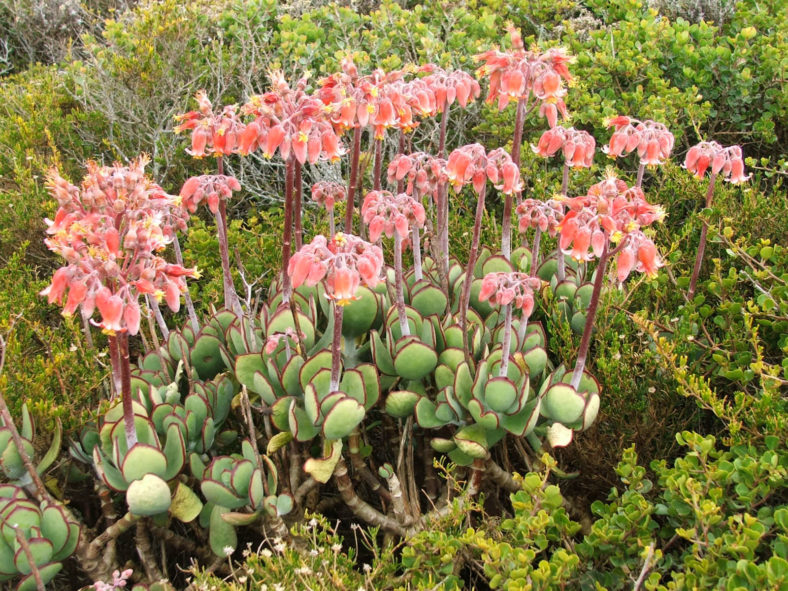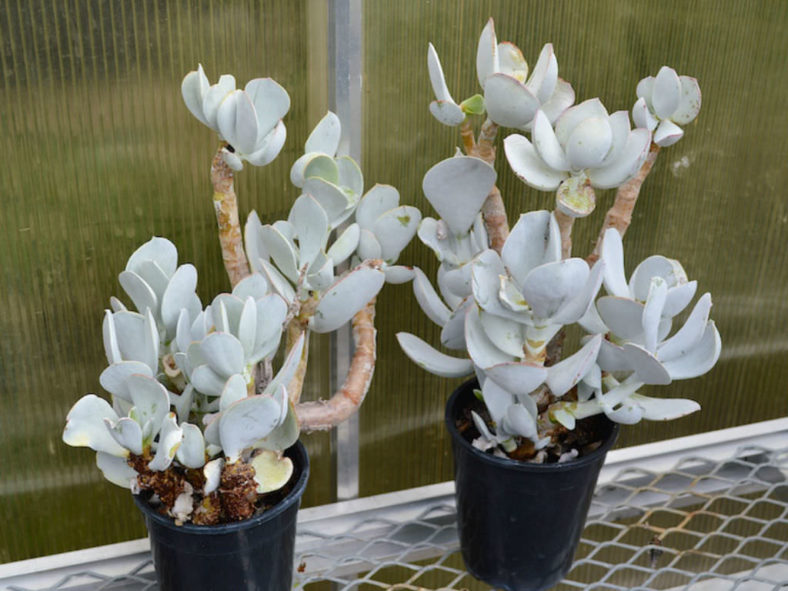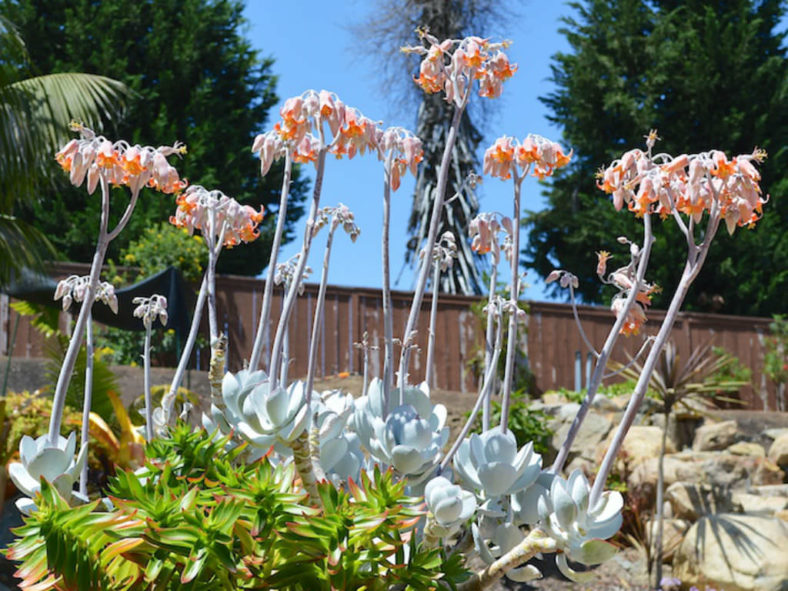Scientific Name
Cotyledon orbiculata L.
Common Name(s)
Pig's Ear, Pig's Ears, Silver Pig's Ears, Round-leafed Navel Wort, Round-leaved Cotyledon, White Lady
Synonym(s)
Sedum orbiculatum
Scientific Classification
Family: Crassulaceae
Subfamily: Kalanchoideae
Genus: Cotyledon
Etymology
The specific epithet "orbiculata" (pronounced "or-bee-kul-AY-tuh") means "rounded, circular, orbiculate" and refers to the shape of the leaves of this species.
Origin
Cotyledon orbiculata is native to Swaziland and South Africa (Cape Province, Mpumalanga, KwaZulu-Natal).
Description
Cotyledon orbiculata is a succulent shrub with erect to decumbent stems and leaves that are highly variable in color, shape, and hairiness. It grows up to 3.3 feet (1 m) tall. The leaves are usually glabrous and inversely oval, but can also be rounded, oval, and can measure up to 4 inches (10 cm) long and 2 inches (5 cm) wide. They are hairy and often have reddish and undulated margins.
The bell-shaped flowers are orange, red, or yellow, and can reach a length of 0.8 inches (2 cm). They droop from the top of a stalk that can grow up to 1.5 feet (45 cm) tall.
In Australia, Cotyledon orbiculata is often sold as Cotyledon 'Dan's Delight' or Cotyledon orbiculata 'Dan's Delight'.
Varieties and Cultivars of Cotyledon orbiculata
- Cotyledon orbiculata var. flanaganii
- Cotyledon orbiculata var. oblonga
- Cotyledon orbiculata var. oblonga 'Flavida'
- Cotyledon orbiculata var. oblonga 'Macrantha'
- Cotyledon orbiculata var. oblonga 'Octopus'
- Cotyledon orbiculata var. oblonga 'Takbok'
- Cotyledon orbiculata var. orbiculata
- Cotyledon orbiculata var. dinteri
- Cotyledon orbiculata 'Cinderella'
- Cotyledon orbiculata 'Elk Horns'
- Cotyledon orbiculata 'Happy Young Lady'
- Cotyledon orbiculata 'Huisrivier Pass'
- Cotyledon orbiculata 'Lighthouse Road'
- Cotyledon orbiculata 'Mucronata'
- Cotyledon orbiculata 'Oophylla'
- Cotyledon orbiculata 'Staghorn'

Hardiness
USDA hardiness zones 9b to 11b: from 25°F (-3.9°C) to 50°F (10°C).
How to Grow and Care
Cotyledons can be divided into two groups. One group consists of evergreen plants with a summer growing period. The other group comprises deciduous plants, splendidly magnificent with large, solid, fleshy stems. The second group grows during the winter and sheds its leaves during the summer.
These succulents require a free-draining, gritty mix and plenty of sunlight. If kept dry, they are tolerant of cool, frost-free conditions during the winter. Some require pruning to maintain an attractive shape. Cotyledons should be kept in a sunny position. Follow general succulent watering procedures. Be careful of overwatering when they are deciduous.
As succulents go, Cotyledons certainly are a rewarding garden and indoor subject, practically independent of irrigation in all but full desert conditions. However, they cannot survive low light or poor drainage.
Feed it once or twice during the growing season with a fertilizer specifically formulated for cactus and succulents (poor in nitrogen), including all micronutrients and trace elements diluted to 1/2 the strength recommended on the label.
Learn more at How to Grow and Care for Cotyledon.
You may want to divide your Pig's Ear because you want more of them. With the right tools and environment, clippings can grow into multiple plants.
Learn more at How to Divide, Propagate, and Transplant a Pig's Ear Plant.
Links
- Back to genus Cotyledon
- Succupedia: Browse succulents by Scientific Name, Common Name, Genus, Family, USDA Hardiness Zone, Origin, or cacti by Genus
Photo Gallery
Click on a photo to see a larger version.


